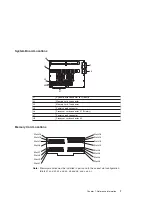
v
The - (dash) separator character represents a normal structural relationship where
the child is a separate physical package and it plugs into (or is connected to) the
parent. For example, P1-C1 is a processor card (C1) plugged into a planar (P1), or
P1-M1 is a memory card (M1) plugged into a planar (P1).
v
The / (slash) separator character separates the base location code of a function from
any extended location information. A group of logical devices can have the same
base location code because they are all on the same physical package, but may
require extended location information to describe the connectors they support. For
example, P2/S1 describes the location of the serial port 1 controller and its connector
(S1), which is located on planar P2 (its base location code), but the / indicates that
further devices can be connected to it at the external S1 serial connector. The
keyboard controller and its connector likewise have location code P2/K1, which
means they have the same base location code (P2) as serial port 1, but a different
external connector. In contrast, the location code P2-K1 actually points to the device
connected to connector K1; that is, the keyboard. The location code P2/Z1 indicates
an integrated SCSI controller which drives connector Z1, while location codes of
P2-Z1-... point to the actual SCSI bus and devices.
v
The # (pound sign) separator character indicates a cable connection between a
connector and parent.
The following are examples:
v
P1-C1 identifies processor card C1 plugged into planar P1.
v
P1-M1 identifies memory card M1 plugged into planar P1.
v
P2/S1 identifies serial port 1 controller on I/O board P2, or the connector for serial
port 1.
v
P1-K1 identifies a keyboard attached to connector K1 on planar P1.
v
P2/Z1 identifies an integrated SCSI controller on planar P2 which drives connector
Z1.
v
P2-Z1-... points to the actual SCSI bus and devices attached to Z1.
The . (period) identifies sub locations (DIMMs on a memory card, or SCSI addresses).
The following are examples:
v
P1-M1.4 identifies memory DIMM 4 on memory card 1 plugged into planar P1.
v
P1-C1.1 identifies processor 1 on processor card 1 plugged into planar P1.
v
P2-Z1-A3.1 identifies a SCSI device with SCSI address of LUN 1 at SCSI ID 3
attached to SCSI bus 1, which is integrated on planar P2.
v
P2.1 identifies a riser card plugged into planar P2.
AIX Location Codes
The basic formats of the AIX location codes are as follows:
v
For non-SCSI devices/drives:
– AB-CD-EF-GH
v
For SCSI devices/drives:
– AB-CD-EF-G,H
10
Service Guide
Summary of Contents for RS/6000 44P Series 270
Page 1: ...RS 6000 44P Series Model 270 Service Guide SA38 0572 02 ...
Page 10: ...x Service Guide ...
Page 14: ...xiv Service Guide ...
Page 16: ...xvi Service Guide ...
Page 20: ...Rear View 1 2 3 4 5 6 7 8 9 11 12 13 14 15 16 10 17 18 19 2 Service Guide ...
Page 44: ...26 Service Guide ...
Page 164: ...146 Service Guide ...
Page 204: ...186 Service Guide ...
Page 247: ...b Slide the covers to the rear and remove Chapter 9 Removal and Replacement Procedures 229 ...
Page 288: ...270 Service Guide ...
Page 290: ...1 2 3 4 5 6 7 8 9 10 11 12 13 14 15 16 17 18 19 21 20 22 23 24 25 272 Service Guide ...
Page 294: ...Keyboards and Mouse 276 Service Guide ...
Page 296: ...Keyboards and Mouse Black 278 Service Guide ...
Page 298: ...Power Cables 1 2 3 4 5 6 7 8 9 10 11 280 Service Guide ...
Page 300: ...282 Service Guide ...
Page 302: ...284 Service Guide ...
Page 304: ...286 Service Guide ...
Page 310: ...292 Service Guide ...
Page 338: ...320 Service Guide ...
Page 345: ......
Page 346: ... Printed in U S A September 2001 SA38 0572 02 ...
















































